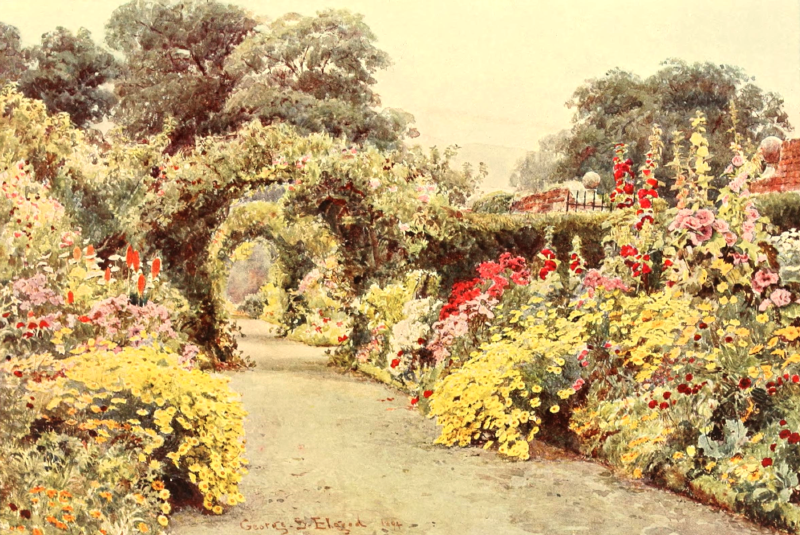| Web
and Book design,
Copyright, Kellscraft Studio 1999-2021 (Return to Web Text-ures) |
 (HOME)
|
|
ABBEY LEIX
In a picturesque,
but little-known district in Queen's County, Ireland, lies Abbey Leix, the
residence of Lord de Vesci. It is a land of vigorous tree-growth and general
richness of vegetation. Hedge-rows show an abundance of well-grown ash timber,
and the park is full of fine oaks, a thing that is rare in Ireland, and that
makes it more like English parkland of the best character. This impression is
accentuated in spring-time when the oaks are carpeted with the blue of wild
Hyacinths, and when the broad woodland rides are also rivers of the same
Blue-bells. In
this favoured land the common Laurel is a beautiful tree, thirty feet high; the
mildness of the winter climate allowing it to grow unchecked. Only those who
have seen it in tree form in the best climates of our islands, or in Southern
Europe, know the true nature of the Laurel's growth, or the poetry and mystery
of its moods and aspects. The long grey limbs shoot upward and bend and arch in
a manner almost fantastic. Sometimes a stem will incline downwards and run
along the ground, followed by another. In the evening half-light they might be giant
silver-scaled serpents, writhing and twisting and then springing aloft and
becoming lost to sight in the dim masses of the crowning foliage. Seen thus one
can hardly reconcile its identity with that of the poor, tamed, often-clipped
bush of every garden. The Laurel is so docile, so easily coerced to the making
of a quickly-grown hedge or useful screen, that its better qualities as an
unmutilated tree in a mild district are usually lost sight of. 
ABBEY-LEIX From the picture in the possession of Sir James Whitehead, Bart. The
house at Abbey Leix is a stone building of classical design of the middle of
the eighteenth century. On the northern front is the entrance forecourt; on the
southern, the garden. Here, next the house, is a wide terrace, bounded on the
outer side by the parapet of a retaining wall, and next the building, by a
running guilloche of box-edged beds filled with low-growing plants. The terrace
has a semi-circular ending, near the eastern wall of the house, formed of an
evergreen hedge, with a wooden seat following the same line, and a sundial at
the radial point. At the other end, the terrace ends in a flight of downward
steps leading to large green spaces, with fine trees and flowering shrubs, and
eventually to the walled gardens. Straight across the terrace from the house is
the parterre, whose centre ornament is an unusually well-proportioned fountain
of the same date as the house. It is circular in plan, with a wide lower basin and
two graduated superimposed tazzas. From this, four cross-paths radiate; the
quarters are filled mainly with half-hardy flowers such as Gladiolus; the
design being accentuated at several points by the upright growing Florence
Court Yews. The parterre is inclosed by a low wall, backed by a clipped
evergreen hedge; on the wall stand at intervals graceful stone figures oi amorini identical in character with
those shown in the picture of Phlox and Daisy, and apparently designed by the
same hand. The
steps at the western end of the terrace are wide and handsome, and are also
ornamented with sculptured amorini.
The path leads onward, at first directly forward, but a little later in a
curved line through a region of lawn and stream, with trees and groups of
flowering shrubs. Here and there, on the grass by itself, is one of the
free-growing Roses, rightly left without any support, and showing the natural
fountain-like growth that so well displays the beauty of many of the Roses of
the old Ayrshire class and of some of the more modern ramblers. The path passes
one end of an avenue of large trees, and, after a while, turning to the left,
reaches the kitchen gardens, consisting of several walled inclosures. One of
these, of which one wall is occupied by vineries, has been made into a flower garden,
where hardy flowers, grandly grown, are in the wide borders next the wall. A
portion of such borders, in an adjoining compartment of the garden, forms the
subject of the picture. The
inner space is divided into two squares, one having as centre a rustic
summer-house almost hidden by climbing plants; from this radiating grass paths
pass between beds of flowers. The outer borders in the next walled compartment
are ten feet wide, and are finely filled with all the best summer plants,
perennial, annual and biennial. The fine pale yellow Anthemis tinctoria is here
grown in the way this good plant deserves, and its many companions. Hollyhocks,
Delphiniums, Japan Anemones, Phloxes and Lavender; annual Chrysanthemums,
Gladiolus, Carnations, Tritomas, and all such good things, are cleverly and
worthily used, and, with the graceful arches of free Roses and white
Everlasting Pea, make delightful garden pictures in all directions. The
garden of Abbey Leix is one of those places that so pleasantly shows the
well-directed intention of one who is in close sympathy with garden beauty; for
everywhere it reflects the fine horticultural taste and knowledge of Lady de
Vesci, who made the garden what it is. |